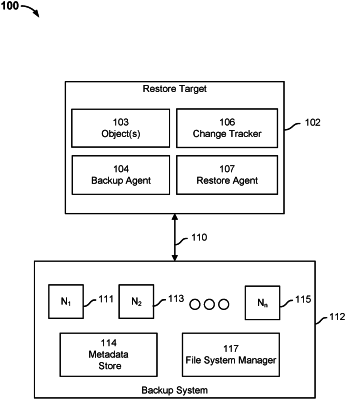| CPC G06F 3/065 (2013.01) [G06F 3/0619 (2013.01); G06F 3/0664 (2013.01); G06F 3/0673 (2013.01)] | 20 Claims |

|
1. A method, comprising:
receiving, at a backup system, a request to restore a specific backup instance of a volume of a recipient system to the recipient system, wherein the recipient system includes a change tracker configured to track changes that have occurred to the volume of the recipient system since a previous backup snapshot, wherein the previous backup snapshot occurred at a first point in time and is associated with a first tracking identifier, wherein the recipient system is configured to perform a backup snapshot based on a last created tracking identifier, wherein the recipient system is configured to perform an incremental backup snapshot of the volume by including one or more changes to the volume of the recipient system that occurred after the first point in time associated with the previous backup snapshot, wherein the first tracking identifier is the last created tracking identifier;
in response to the received request to restore the specific backup instance, creating, at a storage associated with the backup system, a new reference backup instance based on the specific backup instance stored at the storage associated with the backup system;
restoring data associated with the specific backup instance to the recipient system from the storage associated with the backup system;
providing to the recipient system a request to generate a new tracking identifier, wherein in response, the recipient system generates the new tracking identifier, wherein the new tracking identifier corresponds to a state of the recipient system at a second point in time, wherein the state of the recipient system at the second point in time includes the restored data associated with the specific backup instance, wherein the new tracking identifier replaces the first tracking identifier as the last created tracking identifier, wherein the second point in time occurred after the first point in time associated with the previous backup snapshot, wherein the recipient system is configured to track one or more changes to the volume that occurred after the second point in time, wherein a first set of one or more changes occurred at the recipient system between the first point in time and the second point in time;
providing the recipient system a request to perform a constructive incremental backup snapshot based on the new tracking identifier, wherein the recipient system utilizes the new tracking identifier to perform the constructive incremental backup snapshot by excluding the first set of one or more changes that occurred at the recipient system between the first point in time associated with the previous backup snapshot and the second point in time associated with the data associated with the specific backup instance being restored to the recipient system and including a second set of one or more changes that occurred at the recipient system after the second point in time associated with the data associated with the specific backup instance being restored to the recipient system; and
receiving and storing data associated with changes to the volume of the recipient system that occurred after the second point in time associated with the data associated with the specific backup instance being restored to the recipient system.
|